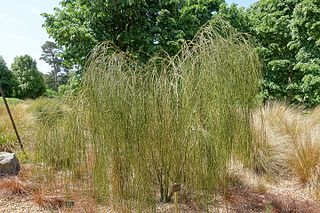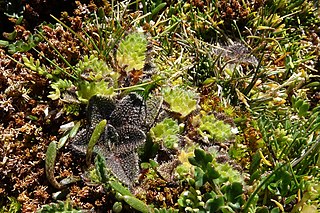
The Władysław Szafer Institute of Botany in Kraków, Poland is a major European herbarium containing a collection of over 650,000 vascular plants, bryophytes, algae, fungi, lichens, and various plant fossils. The vascular plant specimens are primarily from Central Europe with a specialization in alpine plants. The bryophytes are Polish, Antarctic and subAntarctic, and East African. The fossil plants are largely Central European. Main publications include Acta Palaeobotanica, and the Polish Botanical Journal.
Ruth Mason was a New Zealand botanist specialising in the taxonomy and ecology of freshwater plants. She was employed at the Department of Scientific and Industrial Research for 35 years undertaking research into aquatic plants, pioneering new techniques for plant preservation and collecting over 13,000 plant specimens in the field. She was awarded life membership by the New Zealand Ecological Society.
The University of Michigan Herbarium is the herbarium of the University of Michigan in Ann Arbor, Michigan, in the United States. One of the most-extensive botanical collections in the world, the herbarium has some 1.7 million specimens of vascular plants, algae, bryophytes, fungi, and lichens, and is a valuable resource for teaching and research in biology and botany. The herbarium includes many rare and extinct species.

Ruppia polycarpa is a submerged aquatic herb species in the genus Ruppia found in shallow brackish waters. It is a common submerged herb on Australasian coasts, including Australia and New Zealand.

Carmichaelia stevensonii, the cord broom or weeping broom, is a species of plant in the family Fabaceae. It is found only in the north east of the South Island of New Zealand. It is threatened by habitat loss.

Eudonia sabulosella is a species of moth in the family Crambidae. This species is endemic to New Zealand and is regarded as being common. The larvae of this species are known to damage pasture in New Zealand.

Audrey Lily Eagle was a New Zealand botanical illustrator, whose work mainly focused on New Zealand's distinctive trees and shrubs. As the author and illustrator of the two volume Eagle's Complete Trees and Shrubs of New Zealand, Eagle made a notable contribution to New Zealand botany.

Geoffrey Thomas Sandford Baylis was a New Zealand botanist and Emeritus Professor specialising in plant pathology and mycorrhiza. He was employed at the University of Otago for 34 years undertaking research into plant and fungal ecology and symbiotic interactions, taxonomy and anatomy. He collected hundreds of plant specimens in the field and founded the Otago Regional Herbarium (OTA). He discovered the sole Pennantia baylisiana living on Three Kings Island in 1945, and was elected as a Fellow of the Royal Society of New Zealand in 1961.
Peter Brian Heenan is a New Zealand botanist.

John Kenneth Bartlett was a New Zealand plant collector and botanist who specialised in mosses, liverworts, and lichens. In 1974, he found Bartlett's rātā growing south-east of Cape Reinga.

David John Galloway, FRSNZ was a biochemist, botanist, and lichenologist.
Brenda Faulkner Shore was a New Zealand botanist who attained the rank of Associate Professor before she retired in 1983.

Xanthoparmelia semiviridis, also known as resurrection lichen is a foliose lichen species in the family Parmeliaceae. Its common name comes from the reaction of a dry sample to moisture. In its dry state it appears like curled-up dry leaf litter on the ground, but after rainfall the lichen will quickly recover, unfurl and become darker in colour. It is found in semi-arid areas across southern Australia and the South Island of New Zealand. The species is in decline in New Zealand because of the loss of habitat resulting from the establishment of dairy farms and vineyards in former indigenous habitat, and the deterioration of existing habitat caused by invasive species such as hawkweeds.

Myosotis cheesemanii is a species of flowering plant in the family Boraginaceae, endemic to the South Island of New Zealand. Donald Petrie described the species in 1886. Plants of this species of forget-me-not are perennial rosettes with bracteate inflorescences and white corollas.

Myosotis colensoi is a species of flowering plant in the family Boraginaceae, endemic to the South Island of New Zealand. Thomas Kirk described the species in 1896. Plants of this species of forget-me-not are perennial rosettes with bracteate inflorescences and white corollas.
Myosotis glabrescens is a species of flowering plant in the family Boraginaceae, endemic to the South Island of New Zealand. Lucy Moore described the species in 1961. Plants of this species of forget-me-not are tightly compacted, perennial mats with bracteate inflorescences and white corollas.

Veronica bishopiana, the Waitākere rock koromiko, is a flowering plant belonging to the family Plantaginaceae. It is native to West Auckland in New Zealand, and was first described by Donald Petrie in 1926.

Myosotis antarcticasubsp. antarctica is a subspecies of flowering plant in the family Boraginaceae, native to New Zealand, Campbell Island, and southern Chile. Joseph Dalton Hooker described the species in his 19th century work Flora Antarctica. Plants of this subspecies of forget-me-not are perennial with a prostrate habit, bracteate inflorescences, and white or blue corollas. It is one of two native Myosotis in the New Zealand subantarctic islands, the other being M. capitata, which also has blue corollas.

Myosotis hikuwai is a species of flowering plant in the family Boraginaceae, endemic to the South Island of New Zealand. Heidi Meudt, Jessica Prebble and Geoff Rogers described M. hikuwai in 2022. Plants of this forget-me-not are spring annuals with bracteate and erect inflorescences, and small, white corollas with inserted stamens. The species is considered Threatened and known only from one population near Wānaka.
James Murray (1923–1961) was an organic chemist at the University of Otago. He was the first twentieth century lichenologist in New Zealand.














